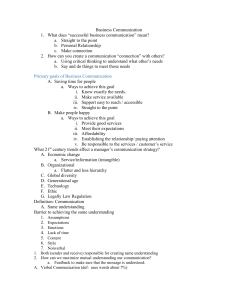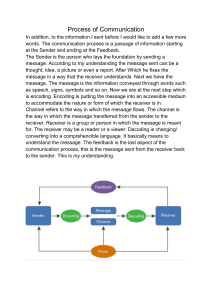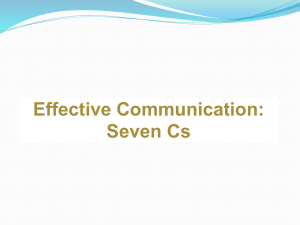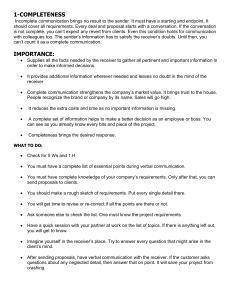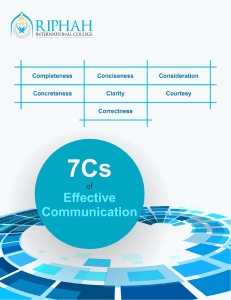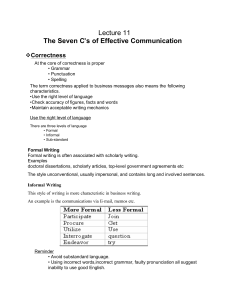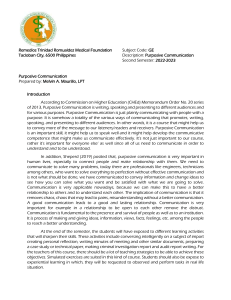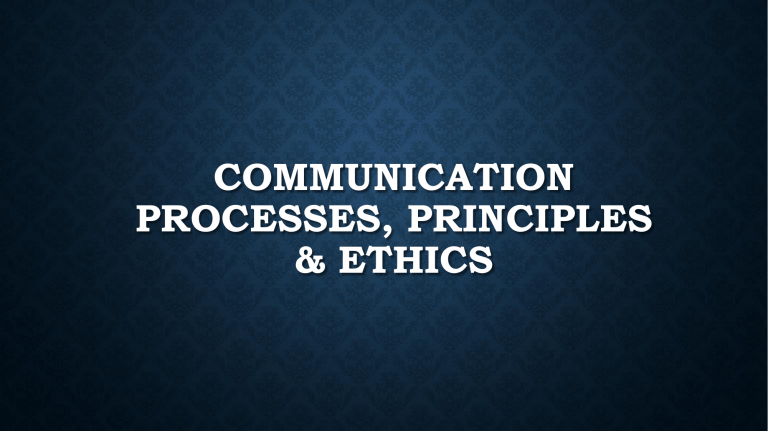
COMMUNICATION PROCESSES, PRINCIPLES & ETHICS “If you can communicate, you can get by. But if you can communicate skillfully, you can work miracles.” -- Jim Rohn OUTCOMES At the end of the lesson you are expected to: • increase knowledge in communication, its processes and principles hence become more skillful communicators; • heighten awareness on communication ethics resulting conscientious and respectful interactions; and • apply the gained knowledge through class exercises TRUE OR FALSE? • Man can not communicate. • Communication is very powerful. • Everything created by the great Creator is incessantly engaged in various forms of communication. • We are always engaged in almost all sorts of communication. • Communication is something continuous and may not have a definite end. WHAT IS COMMUNICATION? • Is a human act of sending (verbal or nonverbal; online of offline) and receiving of messages where interpretations are normally constructed in the process. • Is a process whereby people create and transmit meaning through the exchange of verbal and nonverbal messages in particular context (Oetzel, 2009:11). • A natural activity of people WHAT THEN IS PURPOSIVE COMMUNICATION? Purposive communication • is an intentional communication that happens within the bounds of specific contexts. • is a communication applied in a specific setting, environment, scene, social relations and culture Contexts affects the process of sending and receiving of messages; semantics or meanings, choice of channels, words and methods of delivery. CONTEXT INCLUDES: 1. Settings or environment – family, school, workplace, religious communities 2. Social relationships – friends, husband and wife, parent child, colleagues/boss-subordinate in the office 3. Scenes which include place, time and occasion – business meeting, job interview, social gathering – parties, weddings, etc.) 4. Culture – history, tradition, beliefs, norms, values ELEMENTS OF COMMUNICATION 1. Sender – source of idea (from WHOM) 2. Message - the idea being communicated (WHAT) 3. Channels – the medium (HOW) 4. Receiver – where the message is going (to WHOM) ELEMENTS OF COMMUNICATION: SENDER – THE MESSAGE WILL ONLY BE AS GOOD AND VALID AS ITS SOURCE • The source of idea • Must be able to use the language that the receiver understands. • Correct grammar • Phonetics • Choice of words or jargons for an appropriate audience • Sentence construction • Discourse competence ELEMENTS OF COMMUNICATION: SENDER – THE MESSAGE WILL ONLY BE AS GOOD AND VALID AS ITS SOURCE • Delivery • Good voice projection • Use of appropriate eye contact • Proper articulation of words and emphasis on important words “It’s not always what you say but how you say it.” Message – What needs to be communicated The FIVE C’s in communication: •Courtesy •Clarity •Conciseness •Concreteness •Completeness THE FIVE C’S IN COMMUNICATION: Courtesy also known as politeness. Ways to demonstrate courtesy: • using polite words and tone to show respect to the receiver of the message. • applying tact and diplomacy • developing the “WE” attitude using positive words instead of negative • being considerate of the feelings of the receiver • selecting gender-free terms • responding promptly to important messages THE FIVE C’S IN COMMUNICATION: Clarity may involve correct word usage, grammar, pronunciation, sentence construction and delivery. Messages which are unclear oftentimes do not achieve their desired effect. THE FIVE C’S IN COMMUNICATION: Conciseness is saying what needs to be said in as few words as possible. Avoid flowery words. Remember: “Our goal is to communicate and not to impress.” THE FIVE C’S IN COMMUNICATION: Concreteness. This refers to being specific. - providing example when necessary makes a message more comprehensible. THE FIVE C’S IN COMMUNICATION: Completeness. To avoid ambiguity, messages should not leave out important details that a receiver expects to know. Answer: What, Who, When, Where, Why and How ELEMENTS OF COMMUNICATION: CHANNELS The choice of channel may depend on the availability, practicality, and its impact on the receiver. Channels: • Telephone • Radio • Television • Printed texts (books, newspapers, magazines, journals, posters, etc.) • Communication technologies (smart phones, tablets, computers) ELEMENTS OF COMMUNICATION: RECEIVER • Must have good listening and comprehension skills • Eliminate all possible distractions or noises • Types of noise (physical, environmental, psychological, emotional) • Sharpness of cognition through continuous studies and acquisition of information and knowledge


